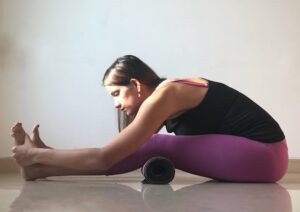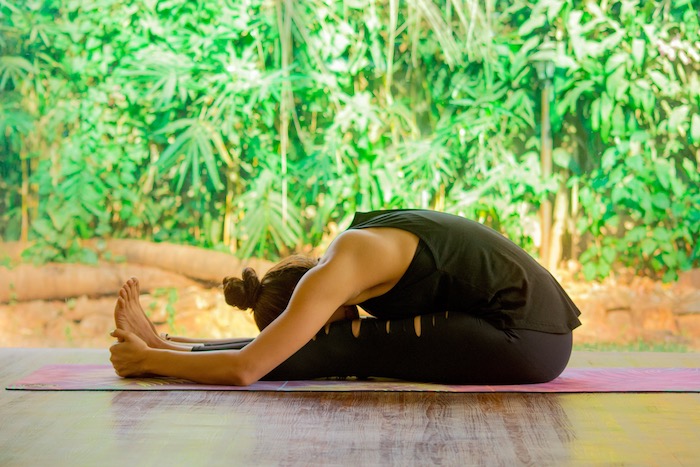Meaning of Paschimottanasana
Paschima means West and Uttana means an intense stretch. Paschimottanasana thus means stretching the west or the back side of our bodies. Of course, there is an assumption here that we are facing east while we practice. East is also the suggested direction to face while practicing Yoga asanas.
The Sanskrit names of Asanas are essential to understanding their meaning. If you are a native Hindi speaker, these terms will be easier to memorize, but if not the best way to remember them is by repeating them as you practice the pose. An added benefit is next time you forget a name get into the pose, and it is very likely that the title will reveal itself. Our brain is wired that way.
How to practice Paschimottanasana:
- Sit on the floor with legs stretched out in front of you in Dandasana.
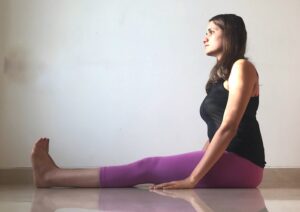
- Make sure the spine is straight, and you make an L shape with your body if it is difficult to keep the spine straight, slightly bend the knees.
- Inhale and raise your hands straight up to lengthen the spine, as if you’re trying to touch the sky with your fingertips
- Maintaining that length, exhale and bend forward and try to touch your toes or shins wherever is accessible
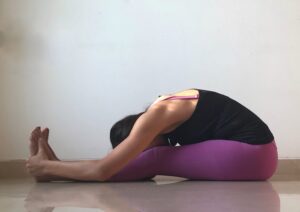
- The body should fold from the hips and not from the spine. In the beginning, we tend to concave the back, overtime work towards lengthening and straightening the back and bending from the hips.
Don’t do this:
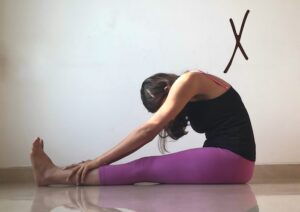
Instead, Do this:
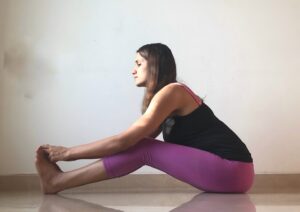
- Stay here for at least 9 to 12 breaths
- Maintaining the length, inhale and rise up with hands stretched up overhead
- Exhale and bring them back down.
Precautions:
- Check that you’re not tightening the upper back while bending forward
- Keep a reasonable distance between the ears and shoulders. Often, to reach the toes, we hunch up the shoulders, tighten the neck muscles and bend from the spine. Be mindful of how your body is moving through positions and approach asanas gently.
- The goal is to bring navel to the thighs and chest closer to the knees – do not try to bring forehead to the knees as that throws the spine out of alignment
Benefits:
- Improves Metabolism and helpful in Diabetes: One of the most significant benefits of Pachimottanasana is that it enhances our metabolism. It directly works on the center of our bodies activating the digestive system including our kidneys. Because it works on the visceral organs, it energizes the pancreas and liver which helps our sugar metabolism and thus also help in Diabetes.
- Relaxes the Heart and improve Blood pressure: Bringing the heart closer to the ground is incredibly resting for us physically as well as mentally. Humans are the only species to have evolved to become bi-pedals that is they walk on two legs and have a unique upright spine. It also means our heart is further away from the ground, unlike our four-legged friends. It increases the pressure and strain as the heart has to pump up blood against gravity and longer distances. That is why Paschimottanasana is an excellent posture to give a much-needed break to the heart and de-stress the body.
- Stretches the back muscles: It is a very active stretch for the spine, back muscles, and our hamstrings.
What to practice before? Paschimottanasana is often done after intense backbends to reset the spine.
What to practice after? Purvottanasana is practice after Paschimottanansana. As the name suggests, it stretches the East (Purva) side of our bodies or the front. A perfect way to counterbalance the seated forward fold.
Tip for beginners: Place a pillow or a rolled mat under your knees to ease into the position. Doing this helps us access the right muscles and to avoid overextending the spine.
